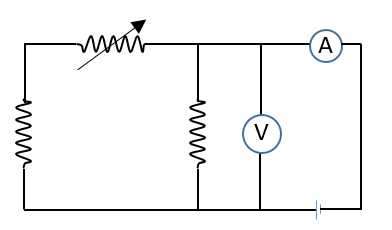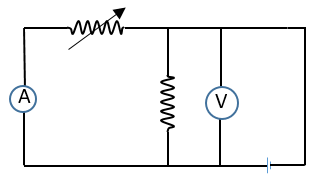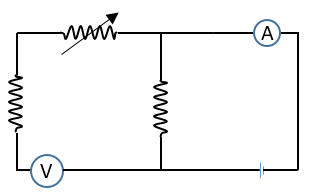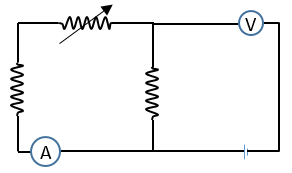
Express which of the following setups can be used to verify Ohm's law?
A. 
B. 
C. 
D. 
Answer
217.2k+ views
Hint: Ohm’s law states that the amount of electric current through a conductor in a circuit is directly proportional to the potential difference applied across the conductor. The voltmeter measures the potential applied and the ammeter measures the electric current flowing through the conductor.
Complete step by step solution:
When a potential difference is applied across a conductor then the electric field is set up inside the conductor which applies force on the charge inside the conductor and hence the charge starts flowing in the direction of the electric field applied.
As we know from the definition of electric current that the magnitude of the electric current is the rate of flow of charge per unit time. And hence, the electric current can be measured using the device called an ammeter.
Ammeter records the amount of charge crossing the area per unit time, hence it should be connected in series in the circuit. So, in the Ohm’s law verification experiment the ammeter should be connected in series to the branch in which we need to measure the electric current.
The voltmeter measures the potential applied across the resistor. When electric current is flowing across the resistor then there is potential drop across the resistor which can be measured using the voltmeter. Hence, the voltmeter should be connected in parallel to across the resistor. In the figure, A the ammeter is connected in series and the voltmeter is connected in parallel. So, this setup can be used to verify Ohm's law.
Therefore, the correct option is A.
Note: In the experiment of Ohm’s law we assume the voltmeter and ammeter as ideal. So, when we record the measurement the recorded data deviates from the theoretical data of Ohm’s law of proportionality because voltmeter and ammeter also have resistance.
Complete step by step solution:
When a potential difference is applied across a conductor then the electric field is set up inside the conductor which applies force on the charge inside the conductor and hence the charge starts flowing in the direction of the electric field applied.
As we know from the definition of electric current that the magnitude of the electric current is the rate of flow of charge per unit time. And hence, the electric current can be measured using the device called an ammeter.
Ammeter records the amount of charge crossing the area per unit time, hence it should be connected in series in the circuit. So, in the Ohm’s law verification experiment the ammeter should be connected in series to the branch in which we need to measure the electric current.
The voltmeter measures the potential applied across the resistor. When electric current is flowing across the resistor then there is potential drop across the resistor which can be measured using the voltmeter. Hence, the voltmeter should be connected in parallel to across the resistor. In the figure, A the ammeter is connected in series and the voltmeter is connected in parallel. So, this setup can be used to verify Ohm's law.
Therefore, the correct option is A.
Note: In the experiment of Ohm’s law we assume the voltmeter and ammeter as ideal. So, when we record the measurement the recorded data deviates from the theoretical data of Ohm’s law of proportionality because voltmeter and ammeter also have resistance.
Recently Updated Pages
Addition of Three Vectors: Methods & Examples

Addition of Vectors: Simple Guide for Students

Algebra Made Easy: Step-by-Step Guide for Students

Relations and Functions: Complete Guide for Students

Analytical Method of Vector Addition Explained Simply

Arithmetic, Geometric & Harmonic Progressions Explained

Trending doubts
JEE Main 2026: Application Form Open, Exam Dates, Syllabus, Eligibility & Question Papers

Derivation of Equation of Trajectory Explained for Students

Hybridisation in Chemistry – Concept, Types & Applications

Understanding the Angle of Deviation in a Prism

Understanding Collisions: Types and Examples for Students

How to Convert a Galvanometer into an Ammeter or Voltmeter

Other Pages
JEE Advanced Marks vs Ranks 2025: Understanding Category-wise Qualifying Marks and Previous Year Cut-offs

Understanding Atomic Structure for Beginners

Ideal and Non-Ideal Solutions Explained for Class 12 Chemistry

Degree of Dissociation: Meaning, Formula, Calculation & Uses

Understanding Electromagnetic Waves and Their Importance

Understanding the Electric Field of a Uniformly Charged Ring




